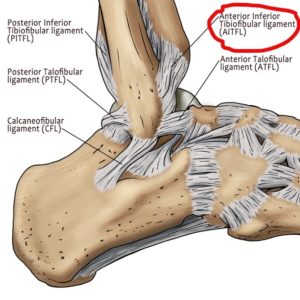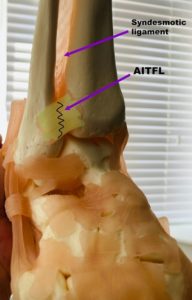This blog continues on from what can I do for an ankle sprain. In this article we explore what you can do if your ankle sprain isn’t getting better, and discusses a high ankle sprain.
What is a high ankle sprain?
Ligaments hold the ankle bones and joints in position. Which protect the ankle joint from abnormal movements such as twisting, turning, and rolling of the foot. Ligaments are elastic like an elastic band, so they stretch and return to their normal shape.
If they stretch more than they are allowed, then they can tear which is known as a sprain. Initially a few fibres tear (a grade 1 injury). Then a few more fibres tear (a grade 2 injury). Finally, the two ends snap apart (a grade 3 injury). Clearly a grade 3 injury is the most severe.


We call it a high ankle sprain when a ligament at the top of the ankle is injured. This ligament goes between the tibia (shin bone) and the fibula (outer bone). And is known as the syndesmosis (phonetically “SIN-des-MO-sis”). The ankle syndesmosis has three strong ligaments one at the back, one in the centre and one at the front.
The commonest to be injured is the one at the front called the Anterior Inferior Tibiofibular Ligament (AITFL). If two of the ligaments are injured (AITFL and the interosseous ligament) then the bones are quite unstable but if all three are injured (AITFL, interosseous ligament and PITFL) then the ankle is very unstable.
Most common ankle sprains injure ligaments called the ATFL or CFL. Whereby it takes a particularly nasty twisting injury to also injure the syndesmotic ligaments.
Why is a high ankle sprain important?
Well for two reasons, firstly because they take much longer to heal. Secondly because when you put weight on the leg, the tibia and fibula experience high forces that want to spread them apart.
The ligaments of the syndesmosis serve to hold them together but allow a tiny bit of side to side and rotational movement of the fibula. So as to accommodate the changing shape of the talus in different foot positions. If the syndesmosis is unstable then you lose confidence with the ankle and it will feel wrong when you cut or turn.
What causes a high ankle sprain?
A high ankle sprain is caused by a severe twisting injury. They are most common in athletes who play high impact sports like soccer, basketball, baseball, and American Football. But can also occur in dancers and runners.
What are the symptoms of a high ankle sprain?
The symptoms are often the same as any ankle sprain, with pain, swelling and bruising in the acute injury. If the syndesmosis is injured the pain may extend up the leg. If it’s a few weeks since you sprained the ankle and the swelling has settled somewhat. But the ankle doesn’t feel quite right or when you try and twist, cut or turn you get pain deep inside the ankle, then you may have a high ankle sprain.
How is a high ankle sprain diagnosed?
The diagnosis of a high ankle sprain is based on the history of how the injury took place. Which is a physical examination where a fibular compression test, sometimes called a “syndesmosis squeeze test” is performed. There are other tests where your foot is twisted into certain positions to see if it causes pain. You may require X-rays or an MRI to supplement the clinical findings.
How do you treat a high ankle sprain?
In the early stages, the treatment is the same as a common ankle sprain. In mild high ankle sprains. I recommend that an ankle brace is used and that exercises are modified for at least 6 weeks. Because high ankle sprains can take longer than common ankle sprains to settle.
For severe high ankle sprains where a ligament is torn through completely, surgery may be required to repair the injury. Surgery usually involves a keyhole procedure (arthroscopy) and then a reconstruction using either screws or an Ankle Tightrope. Which is a piece of tape that holds the two bones from splaying.
How long does it take to recover from a high ankle sprain?
Recovery time varies depending on the severity of the injury. If one of the three syndesmotic ligaments is injured it may simply delay return to sports by a few weeks. If all three of the syndesmotic ligaments are injured and surgery is required. Then you may not be able to return to sport for as long as 6 months. Somewhere between 6 weeks to 6 months is the time frame for most patients.
Did you enjoy this article? You may also like What can i do for an ankle sprain?
Five ways to recover from an ankle sprain

